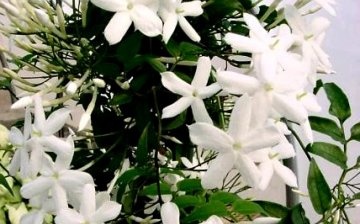Jasmine - houseplant
When we hear the word - jasmine, a picture of a bush is immediately projected in our head. Lush bush with pleasant smelling flowers. In fact, jasmine is a vine with white flowers. And it is quite possible to say that jasmine is a houseplant. It has small flowers that are grouped into inflorescences of 5-6 pieces. The flower is about 25 mm in diameter. This plant has a pleasant and persistent flower scent.
This plant is very easy to grow. Jasmine has no requirements for the characteristics of the land, nor for the daylight regime. But the moisture must be monitored. This plant loves moist soil. In the summer, you should spray the jasmine as often as possible. In winter, it is sprayed once a month.
Indoor jasmine does not tolerate drafts, and grows best at a temperature of 20 degrees. In winter, the temperature can drop, but not below 8 degrees. Although jasmine is not demanding on light, it is best to place it on eastern windows during flowering.
As for the transplant of this plant, it is best to carry it out once a year. In the case when the plant is adult, transplant it no more than once every 3 years. It is best to do this procedure in the spring (mid-March).
You can feed jasmine with various mineral and organic fertilizers. It is best to apply the top dressing in liquid form. During the growth period, potash fertilizers can be applied. The plant should be fed no more than once a decade.
Indoor jasmine is propagated by cuttings or branches. This is best done in the spring. For cuttings, one-year-old shoots are used, which take root better and give fast flowering. Good luck with growing jasmine and beautiful flowers.




Is indoor jasmine grown as a bonsai? Does the plant look like a small tree? I just never saw it on sale.